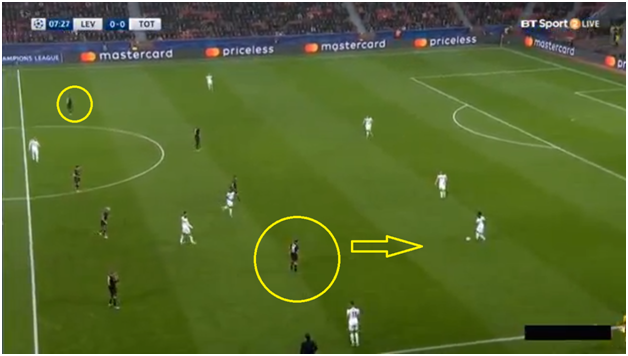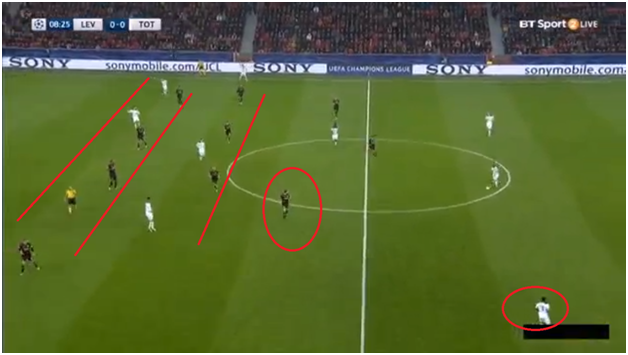Raghunandhanan Narasimhan writes a detailed tactical analysis about the UEFA Champions League match that ended Leverkusen 0-0 Spurs.
Roger Schmidt was in the stands at White Hart Lane when Spurs faced Man City and won 2-0. He would have surely been impressed by seeing the team from North London. It showed in his team’s performance against Spurs that he had done his homework with a very tactically astute performance from Leverkusen.
With two very similar teams in terms of their wanting to press, the way the match would pan out depended on how each team would combat the other’s pressing.

Made using TacticalPad
Leverkusen: 1.Leno 39.Hendrichs 21.Toprak 4.Tah 8.Bender 44.Kampl 20.Aranguiz 10.Calhanoglu 14.Mehmedi 7.Hernandez 11.Kiessling
Tottenham: 1.Lloris 16.Trippier 15.Dier 5.Vertonghen 3.Rose 12.Wanyama 23.Eriksen 20.Alli 7.Son 11.Lamela 9. Jansen
Leverkusen press high up the pitch in the opening minutes

Both the teams set about pressing each other high up the pitch. Leverkusen pressed with a very compact 4-4-2. An early feature of their pressing was that they let the central defenders have the ball when Spurs were in possession. Leverkusen closed down all the passing lanes with the defenders passing amongst themselves. Here below we see Leverkusen right winger Mehmedi going further up the pitch when left back Rose had the ball. We however see that Calhanoglu on the other side is staying bank in the midfield 4. Bender moved up and made up the numbers in midfield. When the ball moved from the central defenders to the wing backs for Spurs, the wide midfielder in the respective side moved up to press. The Leverkusen midfielders moved up in accordance and closed down the spaces. This effectively made sure that all the passing lanes were covered.
Also, Leverkusen made sure that either Alli or Eriksen did not receive the ball in between the lines on the half turn. With the winger pressing the respective full back on the flank, the forwards could cut out the passing lanes for the Spurs central defenders even though they were pressed. Playing a high line, Leverkusen tempted Spurs into long balls with Toprak and Tah being more than able in the air. The second balls could be won with their compact structure. This was not the case all the time in the first half with Spurs implementing their own press and winning the ball high up the pitch at times.

Leverkusen played a very high line and a flat back with an offside trap. Typical of their usual play they were very compact. The distance between the back line and the forwards was not more than 35 yards for most part of the game. Here we see that Danny Rose has moved wide to receive the ball. Leverkusen, who defend in a 4-4-2 were often seen in somewhat a 3-4-3 with the wide player as previously said, moving to close down the respective full back. Bender or Henrichs moved up accordingly when this press was implemented.
Tottenham build up from back despite press
Spurs are more than competent at retaining the ball but could not generate much with Leverkusen pressing in a very organized manner. Dier and Vertonghen had a lot of the ball but were forced to pass sideways or back due to lack of passing options. Spurs however looked to invite the press on to them in order to create space to attack. This proved to be effective as Spurs were the better team as the half wore on. There were a lot of passes between the central defenders and Lloris so that the first line of pressure could be invited on to them to create space for Eriksen and Alli to operate upon. They did not achieve much success with this though with Leverkusen having a very compact second line of pressure in the midfield right behind. However, when Spurs did manage to pass their way around Leverkusen’s press, they enjoyed a lot of space.
Here we see an instance in the first half where Spurs overcame the press:

Lloris has the ball here with the centre backs being split. Wanyama drops down to receive the ball.

Next we see Vertonghen receive the pass from Wanyama with five Leverkusen players having moved up. The space opens up now for Tottenham to build with ease.

We see that as Trippier moves up with the ball, there is no one in the middle for Leverkusen for cover and Alli is seen calling for the ball.

Tottenham were equal to Leverkusen in the first half. Shading the possession battle in the first half, Tottenham defended in 4-1-4-1 with Wanyama covering the spaces in between the lines. Leverkusen failed to make much of an impact in build up with a 4-2-2-2 with Kampl and Aranguiz in the center. They did not have much joy with Spurs being disciplined. With Lamela and Son moving into the half spaces, Spurs created overloads to move their way up to goal. They even had a goal ruled out for offside and Jansen hit the crossbar. Having overcome the initial wave of pressure, Spurs looked to be comfortable and caused Leverkusen problems with their build up play.
Substitution tilts the game towards Leverkusen in the second half
Both managers made changes at half time with Dembele coming in for Spurs instead of Jansen while Schmidt brought in Julian Baumgartlinger for the ineffective Calhanoglu. Kampl moved to the left with the substitute slotting in central midfield. It proved to be decisive as Kampl influenced play much more from the left while Baumgartlinger broke up play. Kampl was very effective out wide against Trippier creating a lot of chances. Pochettino recognized the need for the press-resistant Dembele to play around the Leverkusen press. He moved Son up front in order to use his space to get behind the high line and also to drop in as a false nine a times to help the midfield. Spurs did not improve on their build up play even with Dembele as Leverkusen dominated proceedings.

via fourfourtwo.com
The attacking dashboard of Spurs in the second half is seen here. Spurs had no control over the second half with no vertical passes going through the middle. Leverkusen played with much more energy and won all the second balls higher up the pitch.

via fourfourtwo.com
The Spurs influence chart shows how the players in the attacking third had minimal impact on the game. The center of the pitch was absolutely dominated by Leverkusen with Spurs struggling in the second half.

via fourfourtwo.com
Kevin Kampl moved to the left wing in the second half and had a telling influence. The above pitch map shows the chances created by Leverkusen in the second half. Only a combination of poor finishing and Hugo Lloris’ heroics kept the score line intact. Another feature in their second half play was how effective Julian Baumgartlinger was. He was very good in breaking up the play and was instrumental in Leverkusen recovering the second balls with excellent positional play. Kampl enjoyed more creative freedom once down the flank and this worked to their advantage. Pochettino brought in Sissoko in the right flank to induce energy and combat the left flank of Leverkusen. Kampl kept mixing his play by both drifting out wide to generate space and also cut in to try killer balls.

via fourfourtwo.com
This is Baumgartlinger’s overall dashboard. With successful tackles, aerial duels and interceptions, he made sure that Leverkusen kept the ball in Spurs’ half.
Conclusion
Hugo Lloris was terrific and made an absolutely stunning save off Hernandez at the start of the second half. The striker should have finished it off in truth but it was no doubt a great save. Having been very comfortable in the first half, Spurs were hanging on in the second half with Leverkusen creating a lot of chances. Roger Schmidt will surely be ruing his side’s lack of clinical finishing and having drawn a game in which they created more than enough to win. Pochettino will have been satisfied with the character his team showed and happy with a well-earned point thanks to Lloris’ brilliance. The substitutions made all the difference in the game until which the match was an even affair.
Read all our tactical analyses here.
Manchester United fan and a tactics afficianado. Loves quality holding midifielders























































